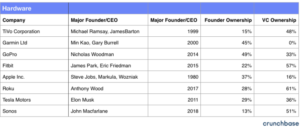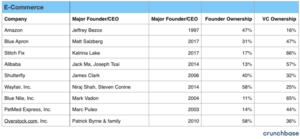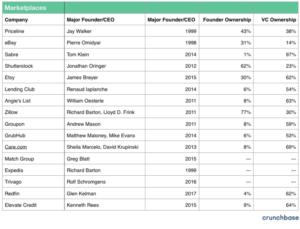How to maximise founder equity on exit
The technopreneur’s equity at exit will vary widely depending on the cash requirements of a particular kind of tech business, the capital efficiency of the business and the valuations that can be achieved.
Snapchat co-founders Evan Spiegel and Robert Murphy owned a combined 37% of Snapchat before it went public. Mark Zuckerberg owned 21% of Facebook, Sergey Brin and Larry Page owned 31% of Google, and Reed Hastings owned 24% of Netflix. These are remarkable levels of CEO ownership and founder equity upon going public/exit, but such high levels aren’t always the case.
Glen Kelman owned only 4% of RedFin, the founders of Pandora owned only 5% combined, and Michael Olson at Cloudera owned 4%.
The point is the range of ownership at exit/IPO can be quite wide and is dependent on a number of factors, the primary of which are capital efficiency and the ability to command high valuations during fundraising.
The list below shows founder ownership and founder equity of 104 tech companies at IPO. The median level of ownership shown is 15% while the average is 21%.



A few points to consider:
- Businesses that tend to be less cash needy have higher levels of ownership for the founders. For instance, e-commerce and hardware, both of which are sectors which tend to generate cash, had median founder ownership levels of 31% and 29% respectively, which is much higher than the median of the entire data set (15%).
- Businesses that have a high level of founder ownership, but were very capital inefficient, were able to preserve founder equity because they raised subsequent rounds at very high valuations. Very few startups have this luxury and it shouldn’t be depended upon to preserve your ownership.
- Both the median and averages of the founders and VC sum to ~70%. That means smaller investors and employees owned 30% of these businesses at IPO. The lesson here is those small investors will be as important to your success as large investors, especially early on. Additionally, option pools are going to need to be set up along the way and sharing equity with your key employees will be critical to growing a large, IPO-worthy business.
There are two ways to maximize founder equity at exit: i) the right way is to be capital efficient and raise as little money as possible to grow the business, or ii) the less common way is to be an incredibly hot startup in a frothy environment so you can raise money at elevated valuations.
Depend on the former if you can because the latter can come and go with cycles.
This is based on an article by Sammy Abdullah, co-founder of Blossom Street , and published by crunchbase.


